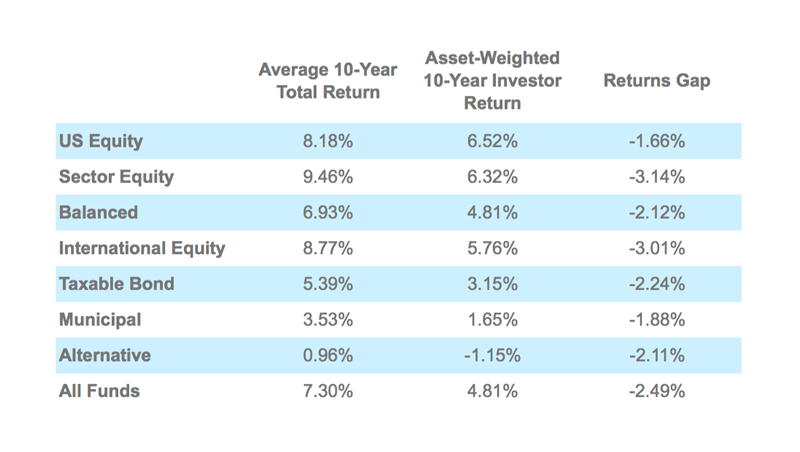How Financial Advisers Can Help Close the Behavior Gap
by David Allison, CFA, CIPM, via CFA Institute
“How will you help me avoid self-destructive investor behavior?”
It might come as a surprise that one of the most important questions investors should ask when vetting financial advisers has little to do with fees or past performance relative to a stock index.
More than six years into a bull market, it is tempting for many to discount the value added by an adviser’s ability to help an investor optimize their behavior. It only takes one rash decision, however, to wipe out many years of investment returns.
Standing pat with a diversified investment portfolio through market ups and downs is easy for researchers to suggest, but difficult for investors to do. In the real world, an investor’s financial situation, attitude towards risk taking, and beliefs about the future direction of financial markets are always changing. Sudden shifts in these factors can tempt them to make poorly timed investment decisions that are based solely on emotions, not logic.
Studies show that, on average, investors sacrifice a substantial portion of their returns by incorrectly timing when to enter and exit investments. Consider the illustration below, which demonstrates that over a 10-year period the average mutual fund investor underperformed the average mutual fund investment by around 2.5% annually.
Asset-Weighted and Average Total and Investor Returns
(Trailing through 31 December 2013)

Source: Morningstar
This oft-cited “behavior gap” between the average investor (money-weighted) return and the average investment (time-weighted) return shows up consistently in research, albeit in varying amounts. There is some debate over whether the size of the gap could be overstated in certain studies due to the return calculation methods used or the pattern of returns over the time period analyzed. But most researchers still agree that it is significant and the result of self-destructive investor behavior — panicking during market downturns or performance chasing.
What Kind of Adviser Can Help Close this Gap?
Financial advisers may cite mutual fund investor performance data similar to the illustration above when arguing that their services are invaluable. But as Carl Richards, author of The Behavior Gap, pointed out at a recent CFA Institute conference, “Most of the money in a mutual fund is advised; it gets there because an adviser put it there.” It is not unreasonable to conclude that many financial advisers are facilitating the self-destructive investor behavior that is so apparent in mutual fund performance data, rather than offering a steady-handed solution.
It is critical for financial advisers to consider how they can keep their clients from making emotional investment mistakes. Below are a few important qualities you should focus on developing to help your clients avoid these ill-advised decisions.
Trust and Communication
A low-cost, well-reasoned investment strategy will not be effective if your client loses trust in it at the wrong time. For this reason, your ability to earn and maintain that trust is just as important as your financial prowess or your ability to minimize costs. Studies suggest that an adviser who is transparent and communicates clearly will be more likely to build trust than one who delivers strong net-of-fee investment performance. But unlike investment performance, skills like the ability to explain risks and manage expectations can be difficult to measure.
You should make sure your clients are comfortable with and have an up-front understanding of your communication process. You should demonstrate how it will work from the outset. Set expectations about the methods of communication you will use, how long it will take you to respond to their inquiries, and how often you plan to make yourself personally available to them.
The Ability to Frame Investment Information around the Big Picture
How a client’s portfolio information is presented will influence how well they make investment decisions. Research suggests that people tend to make mistakes by considering new investment opportunities in isolation, without fully accounting for how the decision will affect the overall risk of their portfolio. Research also shows people often evaluate investment performance too myopically. Viewing their investment information from a narrow perspective or “narrow framing” can tempt clients to chase performance and take risks that are misaligned with their objectives. It is important to be the sort of adviser who helps them focus on the big picture.
Show your clients that you are willing to spend quality time interviewing them about their financial situation and past investing experiences before recommending a specific investment strategy. Also make an effort to provide investment information in the right context and with the right emphasis. For example, many advisers augment the information contained in brokerage account statements with their own in-house performance reports. It is helpful if you offer customized reports that consolidate your clients’ accounts, incorporate their specific investment goals, and emphasize the long-term performance of their entire investment portfolio rather than its individual components.
An Organized Investment Process and Automation
Systematizing investment processes and automating good decisions are among the best ways to keep your clients from making emotional investment mistakes. When hiring an adviser your clients should expect to gain access to an organized and measurable investment process. They should expect you to help minimize the battles they fight with their financial willpower by automating good investment decision making.
Having a systematic investment process and the technology to implement it allows you to spend more time focusing on high-impact investment decisions and communicating with your clients. Make sure you can clearly explain how your repeatable investment process will benefit them. Also demonstrate that you have the ability to help them automate good financial decisions such as portfolio re-balancing and systematic contributions and withdrawals.
Ben Graham, the father of value investing, once warned, “Individuals who cannot master their emotions are ill-suited to profit from the investment process.” Communicating clearly, providing investment information in the right context with the right emphasis, and automating good financial decisions are among the tools you can use to help your clients avoid self-destructive investor behavior.
Use this information to start a conversation with your clients today about ways to close the behavior gap. What are some of the tools you use to keep clients from falling into behavioral traps? Let us know in the comments below.
If you liked this post, don’t forget to subscribe to the Enterprising Investor.
All posts are the opinion of the author. As such, they should not be construed as investment advice, nor do the opinions expressed necessarily reflect the views of CFA Institute or the author’s employer.
Image credit: ©iStockphoto.com/Hong Li
About David Allison
David L. Allison, CFA, CIPM, is vice president and founding partner at Allison Investment Management, LLC. He has formal training in investment analysis, portfolio management, and investment performance measuring techniques. Allison has extensive experience managing investment portfolios for high net-worth investors. He is an active member of CFA Institute, the CIPM Association, CFA North Carolina, and the CFA Society of South Carolina, where he is a former president and currently serves on the board of directors. Allison also serves on the Coastal Carolina University Wall College of Business Finance Advisory Board. He holds of degree in finance from the University of North Carolina at Wilmington.
Copyright © CFA Institute
















